✅ Prescription (Indications):
This combination is primarily prescribed for:
- Parkinson’s disease
- Parkinsonian syndrome, including:
- Idiopathic Parkinsonism
- Post-encephalitic Parkinsonism
- Drug-induced Parkinsonism (e.g., antipsychotic side effects)
📄 Description:
- Active Ingredients:
- Levodopa (100 mg): A dopamine precursor that crosses the blood-brain barrier and converts into dopamine to relieve Parkinsonian symptoms.
- Carbidopa (25 mg): A peripheral dopa-decarboxylase inhibitor. It reduces the breakdown of Levodopa in the bloodstream, allowing more to reach the brain and minimizing peripheral side effects (like nausea and low BP).
- Form: Oral tablet
- Usual Brands:
- Sinemet 100/25
- Syndopa Plus (100/25)
- Parcopa
- Atamet
- Mechanism of Action:
- Levodopa replenishes depleted dopamine in the brain.
- Carbidopa enhances Levodopa’s effect by preventing its premature conversion to dopamine outside the brain.
🌟 Advantages:
- Provides effective motor symptom control in Parkinson’s disease
- Carbidopa boosts Levodopa’s bioavailability, allowing lower doses
- Reduces Levodopa-induced nausea, vomiting, and hypotension
- Improves mobility, tremor, rigidity, and bradykinesia
- Standard ratio (100:25) is better tolerated than 100:10 formulation
⚗️ Nature of the Drug:
- Class: Dopaminergic antiparkinsonian agent
- Type: Combination drug, prescription-only
- Route: Oral
- Standard Dosing: 1 tablet 3–4 times daily initially, adjusted individually
- Onset of action: ~30–60 minutes
- Duration: 5–6 hours per dose (varies)
- Half-life: ~1.5 hours (Levodopa), extended when combined with Carbidopa
📦 Common Packaging:
- Blister packs: Usually 10 tablets per strip
- Box: Commonly 100 tablets (10 strips of 10 tablets)
- Tablet appearance: Varies by brand; often round and scored
🧊 Storage:
- Store below 25°C (77°F)
- Protect from light, heat, and moisture
- Keep out of reach of children

